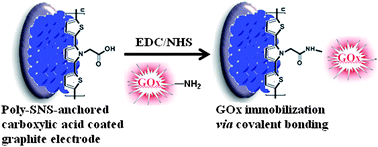Synthesis and application of poly-SNS-anchored carboxylic acid: a novel functional matrix for biomolecule conjugation†
Abstract
Here we report the synthesis of a novel conducting

* Corresponding authors
a
Department of Biotechnology, Middle East Technical University, Ankara, Turkey
E-mail:
toppare@metu.edu.tr
Fax: +903122103200
Tel: +903122103251
b
Department of Chemistry, Middle East Technical University, Ankara, Turkey
E-mail:
tanyeli@metu.edu.tr
Fax: +903122103200
Tel: +903122103222
c Department of Biochemistry, Faculty of Science, Ege University, Izmir, Turkey
d Department of Polymer Science and Technology, Middle East Technical University, Ankara, Turkey
e TÜBİTAK Marmara Research Center Energy Institute, Kocaeli, Turkey
Here we report the synthesis of a novel conducting

 Please wait while we load your content...
Something went wrong. Try again?
Please wait while we load your content...
Something went wrong. Try again?
F. Ekiz, F. Oğuzkaya, M. Akin, S. Timur, C. Tanyeli and L. Toppare, J. Mater. Chem., 2011, 21, 12337 DOI: 10.1039/C1JM12048D
To request permission to reproduce material from this article, please go to the Copyright Clearance Center request page.
If you are an author contributing to an RSC publication, you do not need to request permission provided correct acknowledgement is given.
If you are the author of this article, you do not need to request permission to reproduce figures and diagrams provided correct acknowledgement is given. If you want to reproduce the whole article in a third-party publication (excluding your thesis/dissertation for which permission is not required) please go to the Copyright Clearance Center request page.
Read more about how to correctly acknowledge RSC content.
 Fetching data from CrossRef.
Fetching data from CrossRef.
This may take some time to load.
Loading related content
